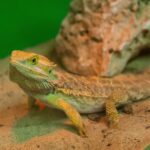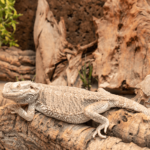Are you a new baby bearded dragon parent? Congratulations! You’re sure to have lots of fun with your little scaly friend. But caring for baby dragons can seem intimidating at first, so let’s break it down with easy-to-follow tips that will keep you from raising a failure (kidding… that too was harsh).
In this article, you’ll learn how to feed and care fot your baby bearded dragon. We’ll cover how to setup a tank for a baby dragon, review a recommended feeding schedule, and how fast a baby bearded dragon will grow.
A baby bearded dragon is all you’ve ever wanted (or at least, it has been for the last couple weeks).
But before you snag the first lizard infant in sight, spend some time and care finding a pet who will be a great fit for your home:
Note: Most breeders or pet stores hold on to babies until they are about 4–6 weeks old. It’s not recommended to re-home a bearded dragon younger than this. They’re too fragile and easily stressed.
You should only purchase a baby bearded dragon from a reputable breeder or pet shop. Wild-caught bearded dragons are often mistreated and obtained unethically or even illegally, so stick with a domesticated dragon from a trusted provider.
When choosing your new friend, look for an active baby with clear eyes, smooth skin, and strong bones. Make sure your beardie can support his weight on all four legs, and that it is active and moving around the enclosure (lethargy, closed eyes, and unhealthy looking skin can be signs of illness).

The “baby” stage for a bearded dragons is short, from birth to the time they are about five months old. Once they hit this mark, they are now considered juvenile—with a whole new set of space and dietary needs.
The most reliable method of sexing a bearded dragon is examining the hemipenal bulges (located near the underside of the base of the tail). These bulges are not fully pronounced until a bearded dragon is about 9–12 weeks old. It is almost impossible for an untrained eye to tell the gender before this stage.
If you buy from an experienced breeder, they might be able to tell you if your baby is a boy or a girl—but even these experts aren’t right every time!
So don’t commit to the whole pink motif for the enclosure until your dragon is old enough to be sexed reliable!
Nothing will make your baby beardie feel at home like a safe, secure enclosure. Taking the extra time to set up a proper habitat will pay off in the long run for both baby and owner.
Baby bearded dragons require much smaller enclosures than their adult counterparts—a 20-gallon tank is usually the max size for baby dragon housing.
Of course, your pet will need to graduate to a larger home as he or she grows. Once your baby reaches the juvenile stage (around 4 months old), you should upgrade them to an enclosure no smaller than 40-50 gallons with lots of climbing space and room for growth.
Some owners up to purchase an adult-sized tank (120 gallons) and let their beardie grow into it. In most cases, this is fine (and financially prudent), but some babies might feel insecure and intimidated with too much space.

All beardies need plenty of light, including UVA and UVB rays, which they require to properly metabolize their food.
In their enclosure, you’ll need:
- UVB lamp
- UVA bulb (50–70 watts)
Leave these bulbs running for 12 hours a day during the day.
Your baby beardie will need a range of temperatures in their tank to stay comfortable. One end of the tank should be cooler (about 75–80 degrees Fahrenheit), while the other side should be a bit hotter (95–105 degrees).
To achieve this effect (known as a temperature gradient), place the heating source (either your heat-producing UVA bulb or a separate basking light) at one end of the enclosure. The other end, far away from the heat-produced light, will stay cooler.
The temperature of the cooler end of the enclosure should not drop below 70°F at night. You’ll need a thermometer to measure these temperatures accurately, and a ceramic heater to run at night if you find the tank is getting too chilly.
Hailing from a semi-arid climate, baby bearded dragons require humidity levels in their tanks of 30–40%.
You’ll need a hygrometer (humidity gauge) to measure this accurately, as well as a spray bottle and/or humidifier if the readings come up on the dry side.
Substrate is the material used to line your baby beardie’s tank. While some owners choose to go with sand, this isn’t recommended for baby dragons. Any small particles can be accidentally ingested, causing serious digestive issues.
Rather than sand, consider using newspaper or tile as a substrate—easy to clean and much safer for baby dragons. If you do decide to use something else, make sure it’s non-toxic and large enough for baby dragons not to accidentally ingest.
Baby bearded dragons require the same decorations as their adult counterparts—a hiding spot for security, some branches for climbing and perching, and plenty of rocks to lounge on.
A rock or log should be set up underneath their basking lamp as well, something comfortable for baby dragons to rest on while they get their daily dose of heat and UV rays
It’s important that baby dragons can explore their habitats safely—make sure there are no sharp edges or anything else baby dragon tykes could injure themselves on!
Baby bearded dragons should eat a protein-heavy diet with portions of green vegetables mixed-in for healthy growth and development. The ratio of protein to plant material should be 75% to 25%. As they grow, the recommended diet becomes much more veggie-centric.
If you are using live crickets the protein source, your baby bearded dragon should eat between 20–40 crickets a day, spread out throughout the day.
Dubia roaches and superworms are acceptable foods as well. Always opt for gut-loaded varieties, as they are more nutritious.
Whichever insect you feed your baby bearded dragon, make sure they are not too big. A good rule of thumb is to choose insects that are about the same size as the distance between your dragons eyes.
Your baby will likely be a voracious eater and rapid grower. Feeding every three hours throughout the day for a total of four meals is the best feeding routine for a baby bearded dragon.
This is a sample schedule you can follow to figure out when to feed your baby:
8 AM: 10 crickets or dubia roaches, small portion of finely chopped collard greens
11 AM: 10 crickets or dubia roaches, small portion of finely chopped collard greens and green bell peppers
2 PM: 10 crickets or dubia roaches, small portion of finely choped broccoli and strawberries
5 PM: 10 crickets or dubia roaches, small portion of finely chopped collard greens and carrots
Tip: Place live insect food in the enclosure first and give your beardie 10 minutes to eat as many as they can. After the 10 minutes, take out the remaining insects and place the veggies (in a small dish or ramekin) in the tank for your pet to snack on until the next feeding).
Bonus Tip: Mix powdered calcium supplement in with your beardie’s food 2–3 times a work to make sure your baby is getting all the nutrients they need to avoid metabolic bone disease.

Your baby bearded dragon will grow fast! While you might wish you could freeze time and keep them small forever, by the time she’s five months old, your baby is now a juvenile.
Babies start out around 3–4 inches long, then grow about 1–3 inches per month through their juvenile stage. Their weight increases from 4–6 grams up to about 102 grams by the time they are a juvenile.
Bearded dragons grow until they become full-sized adults at about 12 months old. Some will keep growing until they are about 18–24 months old.
Adult female bearded dragons will reach 16–20 inches in length, males grow to a slightly larger size of 18–24 inches long.
(Cherish your little buddy’s diminutive size while it lasts!)
Bearded dragons are gentle creatures and can be handled, but baby dragons require extra care. Handle your baby very carefully and only for short periods at first until they are comfortable with it.
Avoid handling baby beardies too frequently as this can cause stress – so handle them just enough to allow them to become accustomed to their human companions.

If your baby is skittish, try putting your hand in the tank with some pieces of their favorite fruit and allowing them to crawl on it until they become comfortable.
(Who could say no to sliced grapes?)
With baby beardies, patience is key! She’ll come around if you give her enough time and love.
Caring for baby bearded dragons requires patience and dedication. They’re not quite as demanding as their human counterparts, but they still require a healthy diet, proper habitat and careful monitoring to ensure their wellbeing.
Remember, you should feed baby bearded dragons 20–40 crickets or dubia roaches a day spread out in four meals throughout the day, along with their plant-based foods and calcium supplements. Provide a comfortable habitat with an adequate temperature gradient and stable climate.
Your baby will grow rapidly and soon enough become an adult bearded dragon. The care you provide at this early stage will ensure your baby dragon grows into a happy, healthy reptile.
Have fun with the process and enjoy watching your baby grow!

![How To Care For A Baby Bearded Dragon [Feeding Tips & More]](https://cdn.shopify.com/s/files/1/0273/0888/4073/files/Dragons_Diet_Feeding_Chart_Final2.png?v=1689020622)




:max_bytes(150000):strip_icc()/13-f9fc54bc64854d20b43e00db91a9cb16.jpg)